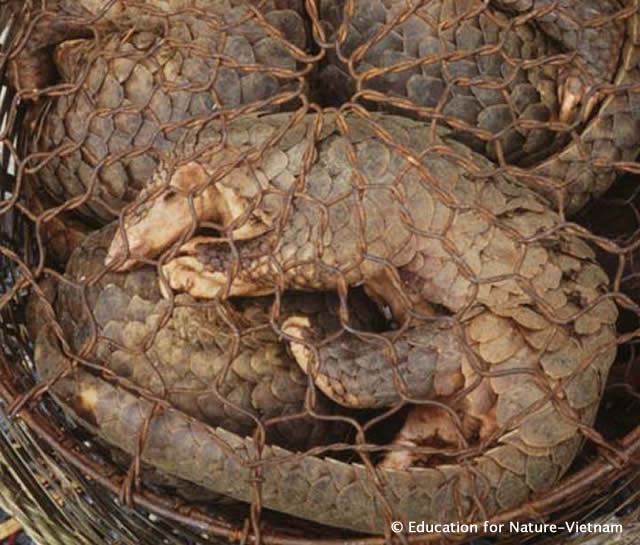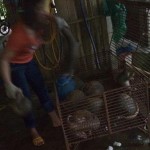In order to maximize profits, wildlife traffickers in Vietnam use brutal techniques to increase the weight of pangolins.
A little-known horror of the illegal pangolin trade is that these defenseless mammals are often forced to endure painful “fattening procedures”.
According to a translated account by Education for Nature-Vietnam, the pangolin is restrained while a tube is inserted down the throat, so that a starchy concoction can be pumped into the helpless animal’s stomach.
Pangolins were taken from the cages and held still by a strong male in the group. A spout was put down the pangolins throat, which was attached to a hand-made pump. The procedure must be done carefully and skillfully because if the spout is inserted incorrectly, into the windpipe for example, the starch could kill the pangolin instantly. Another person pumped the starch slowly through the spout until the stomach was full.
A pangolin’s weight is said to increase by 2 – 5 kg after undergoing the “procedure”.
However, force feeding isn’t the only way that traffickers torture their victims.
Research published by TRAFFIC Southeast Asia notes that pangolins are also “injected” with liquids.
Pangolins in Viet Nam are sold according to weight. The health of live pangolins in the trade is further compromised by a cruel practice designed to increase the live weight of pangolins for sale. Corn flower mixed with water or other liquids are often force fed or injected under the skin of pangolins.
Tragically, tens of thousands of pangolins are killed on a yearly basis to satisfy an insatiable illegal market for pangolin scales and flesh — both of which are consumed in China for purported “health benefits”.
Hope for pangolins
Fortunately, there is hope for the scaly anteaters.
Earlier this year, a new IUCN-SSC Pangolin Specialist Group was established in order to be “a global voice for pangolins by working to advance knowledge and understanding of pangolins worldwide, their conservation needs, natural history and ecology and to catalyze action to meet these needs.”
Comprised of researchers from around the world, the pangolin specialist group will be examining issues “ranging from illegal trade, pangolin ecology, genetics and behavior.”
Photo used with permission and courtesy of Education for Nature-Vietnam.
Additional source: Sandrine Pantel and Chin Sing Yun (ed.). 2009. Proceedings of the Workshop on Trade and Conservation of Pangolins Native to South and Southeast Asia, 30 June-2 July 2008, Singapore Zoo, Singapore. TRAFFIC Southeast Asia, Petaling Jaya, Selangor, Malaysia
Author: Rhishja Cota-Larson. Learn more about Rhishja here.



![Pangolin Trafficking: 2011 to October 2013 [Infographic]](http://pangolins.org/wp-content/uploads/2015/08/WorldPangolinDay2013-01-copy-150x150.jpg)

Comments are closed.